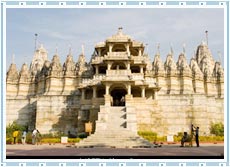 Ranakpur
Temples are acclaimed world-wide for their intricate and superb
architectural style. These temples form one of the five major
pilgrimages of the Jains. Located in village of Ranakpur near Sadri town
in the Pali district of Rajasthan, Ranakpur temple lies at a distance of
95 kms in the north of Udaipur city. The temple is easily accessible
from the city of Udaipur as regular buses are easily available. Built in
the 15th century, Ranakpur temples are known for being the largest and
most important temples of the Jain cult.
Ranakpur
Temples are acclaimed world-wide for their intricate and superb
architectural style. These temples form one of the five major
pilgrimages of the Jains. Located in village of Ranakpur near Sadri town
in the Pali district of Rajasthan, Ranakpur temple lies at a distance of
95 kms in the north of Udaipur city. The temple is easily accessible
from the city of Udaipur as regular buses are easily available. Built in
the 15th century, Ranakpur temples are known for being the largest and
most important temples of the Jain cult. The temple is said to have been built by Seth Dharna Sah (a Jain businessman) with the aid of Rana Kumbha, who ruled Mewar in the 15th century. Ranakpur got its name after the name of the Rajput Monarch and likewise the temples. The temple complex is positioned in an isolated valley on the western side of the Aravalli Range. The Jain Temples of Ranakpur are certainly creditable for their splendid architecture. This temple is wholly constructed in light colored marble and comprises a basement covering an area of 48000 sq feet. There are more than 1400 exquisitely carved pillars that support the temple.
In the complex, there are several temples including Chaumukha temple, Parsavanath temple, Amba Mata Temple and Surya Temple. Amongst all of them, Chaumukha Temple is the most important and as the term Chaumukha suggests, this temple is four-faced. Chaumukha temple is dedicated to Lord Adinath, who is the first 'Tirthankara' of the Jains. The Temple structure is highly compound having four different doorways to get into the chambers. These chambers ultimately take you to the main hall where the image of Adinath is positioned.
The four faced image also symbolizes the Tirthankara's quest for the four directions and ultimately the cosmos. The image is surrounded by many small shrines and domes. One more range of cells with separate roofs encircles these shrines and domes all over again. The five spires elevate above the walls and around 20 cupolas rise from roof of the pillared hall. Each spire houses a shrine and the largest shrine is the important one that addresses the central altar. The temple ceilings are festooned with foliate scrollwork and geometric patterns.
The temple is a masterpiece of architecture and boasts of not less than four additional shrines. It has 24 pillared halls with 80 domes that are supported by 400 columns. The upper and lower parts of the domes are linked by brackets that have deities' sculptures. Above all, you would be amazed to see at a height of 45 feet engraved nymphs playing the flute in various dance postures. Each column is intricately carved and it is surprising to know that no two columns have the similar design.
Apart from this, another stunning act about these columns is that they change their color from golden to pale blue after every hour during the day. In the mandap (prayer hall), the two big bells of 108 kg each produce a harmonious sound on the movement. Chaumukha temple is formed like a Nalinigulm Vimana (heavenly aircraft) and provides this whole structure a celestial appearance. Conceivably, it is due to the intricacy of the structure that the temple took approximately 65 years to complete.
The Temple of Parsavanath is another attraction that is worth visiting. Built in the mid 15th century, the temple is renowned for its engraved windows embellished with Jain figures. Parsavanath Temple is also known as Patriyon Ka Mandir. In close proximity to this temple, you can trace two other temples dedicated to Neminath (22nd saint) and Surya Narayan (Sun God) respectively. Here, Surya Narayan Temple has innumerable wall projections with circular structure. The sight of Lord Surya driven in his chariot of seven horses is truly pleasing.
Ranakpur Temple was also nominated amongst the top 77 wonders, while deciding for new Seven Wonders of the World. However, number of wonders cannot be increased and some or the other would come amongst the top seven, still Ranakpur Temple is undoubtedly a wonder. If you are on a trip to Udaipur, don't miss this artistic temple that would become an unforgettable part of your beautiful memories.
